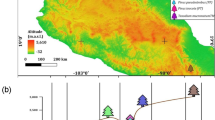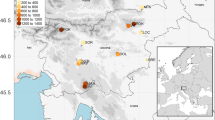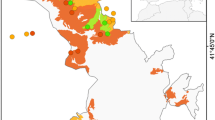Abstract
The potential effects of global changes on forests are of increasing concern. Dendrochronology, which deals with long-term records of tree growth under natural environmental conditions, can be used to evaluate the impact of climatic change on forest productivity. However, assessment of climatic change impacts must be supported by accurate and reliable models of the relationships between climate and tree growth. In this study, a bioclimatic model is used to explore the relationships between tree radial growth and bioclimatic variables closely related to the biological functioning of a tree. This model is at an intermediate level of complexity between purely empirical and process-based models. The method is illustrated with data for 21 Aleppo pine (Pinus halepensis Mill.) stands grown under a Mediterranean climate in south-east France. The results show that Aleppo pine growth is mainly controlled by soil water availability during the growing season. The bioclimatic variable which best expresses the observed inter-annual tree growth variations is the actual evapotranspiration (AET). Four parameters were adjusted to simulate dendrochronological data: the soil water capacity, the wilting point, the minimum temperature for photosynthesis, and the end of the growing season. The bioclimatic model gives better results than the standard response function and provides better insight into the functional processes involved in tree growth. The convincing results obtained by the bioclimatic model as well as the limited numbers of parameters it requires demonstrate the feasibility of using it to explore future climatic change impacts on Aleppo pine forests.





Similar content being viewed by others
References
Becker M (1979) Indices de climat lumineux combinant pente et exposition. Bull Ecol 10:125–137
Becker M (1984) Indices de climat lumineux selon la pente et l’exposition pour les latitudes de 40 à 50°. Bull Ecol 15:239–252
Becker M (1989) The role of climate on present and past vitality of silver fir forests in the Vosges mountains of northeastern France. Can J For Res Rev Can Rech For 19:1110–1117
Boreux J-J, Gadbin-Henry C, Guiot J, Tessier L (1998) Radial tree-growth modelling with fuzzy regression. Can J For Res Rev Can Rech For 28:1249–1260
Borghetti M, Cinnirella S, Magnani F, Saracino A (1998) Impact of long term drought on xylem embolism and growth in Pinus halepensis Mill. Trees 12:187–195
Botkin DB, Janak JF, Wallis JR (1972) Some ecological consequences of a computer model of forest growth. J Ecol 60:849–872
Briffa KR (1992) Increasing productivity of “natural growth” conifers in Europe over the last century. Tree rings and environment. Lund University, Department of Quaternary Geology, Ystad, pp 64–71
Briffa KR, Jones PD, Schweingruber FH, Karlen W, Shiyatov SG (1996) Tree-ring variables as proxy-climate indicators: problems with low-frequency signals. In: Jones PD, Bradley RS, Jouzel J (eds) Climatic variations and forcing mechanism of the last 2000 years. Springer, Berlin Heidelberg New York, pp 9–41
Brochiero F (1997) Ecologie et croissance du pin d’Alep en Provence calcaire. CEMAGREF, Aix-en-Provence
Brochiero F, Chandioux O, Ripert C, Vennetier M (1999) Autécologie et croissance du Pin d’Alep en Provence calcaire. For Méditer XX:83–94
Cherubini P, Gartner BL, Tognetti R, Braker OU, Schoch W, Innes JL (2003) Identification, measurement and interpretation of tree rings in woody species from Mediterranean climates. Biol Rev 78:119–148
Constable JVH, Friend AL (2000) Suitability of process-based tree growth models for addressing tree response to climate change. Environ Pollut 110:47–59
Deleuze C, Houllier F (1998) A simple process-based xylem growth model for describing wood microdensitometric profiles. J Theor Biol 193:99–113
Devaux J-P, Le Bourhis M (1978) La limite septentrionale du Pin d’Alep en France. Etude dendroclimatologique de l’impact des froids exceptionnels. Rev Biol Ecol Méditer V:133–158
Efron B (1979) Bootstrap methods: another look at the jacknife. Ann Stat 7:1–26
FAO (1990) FAO–UNESCO soil map of the world. Revised legend. FAO, Rome
Federer CA (1982) Transpirational supply and demand: plant, soil, and atmospheric effects evaluated by simulation. Water Resour Res 18:355–362
Federer CA, Tritton LM, Hornbeck JW, Smith RB (1989) Physiologically based dendroclimate models for effects of weather on red spruce basal-area growth. Agric For Meteorol 46:159–172
Foster J, LeBlanc D (1993) A physiological approach to dendroclimatic modeling of oak radial growth in the midwestern United States. Can J For Res Rev Can Rech For 23:783–798
Friedlingstein P, Fung I, Holland E, John J, Brasseur G, Erickson D, Schimel D (1995) On the contribution of CO2 fertilization to the missing biospheric sink. Global Biogeochem Cycles 9:541–556
Fritts HC (1976) Tree rings and climate. Academic, London
Fritts HC, Vaganov EA, Sviderskaya I, Shashkin A (1991) Climatic variations and tree-ring structure in conifers: empirical and mechanistic model of tree-ring width, number of cells, cell size, cell-wall thickness and wood density. Clim Res 1:97–107
Fritts HC, Shashkin A, Downes GM (1999) A simulation model of conifer ring growth and cell structure. In: Wimmer R, Vetter RE (eds) Tree-ring analysis. CAB International, Wallingford, pp 3–32
Gadbin-Henry C (1994) Etudes dendroécologique de Pinus pinea L. Aspects méthodologiques. PhD Thesis, Aix-Marseille III, Marseille
Granier A, Biron P, Lemoine D (2000) Water balance, transpiration and canopy conductance in two beech stands. Agric For Meteorol 116:269–283
Graumlich LJ, Brubaker LB, Grier CC (1989) Long-term trends in forest net primary productivity: Cascade Mountains, Washington. Ecology 70:405–410
Guehl JM (1985) Etude comparée des potentialités hivernales d’assimilation carbonée de trois conifères de la zone tempérée (Pseudotsuga menziesii Mirb., Abies alba Mill. Picea ecelsa Link.). Ann Sci For 42:23–38
Guiot J (1991) The bootstrapped response function. Tree Ring Bull 51:39–41
Harrison SP, Prentice CI, Guiot J (1993) Climatic controls on Holocene lake-level changes in Europe. Clim Dyn 8:189–200
Hättenschwiler S, Körner C (1996) Effect of elevated CO2 and increased nitrogen deposition on photosynthesis and growth of understorey plants in spruce model ecosystems. Oecologia 106:172–180
Haxeltine A, Prentice IC (1996) BIOME3: an equilibrium terrestrial biosphere model based on ecophysiological constraints, resource availability, and competition among plant functional types. Global Biogeochem Cycles 10:693–709
IPCC (2001) Climate change 2001: impacts, adaptation and vulnerability. Cambridge University Press, Cambridge
Jacoby GC, D’Arrigo RD (1995) Tree ring width and density evidence of climatic and potential forest change in Alaska. Global Biogeochem Cycles 9:227–234
Jarvis PG, MacNaughton KG (1986) Stomatal control of transpiration: scaling up from leaf to region. Adv Ecol Res 15:1–49
Kirschbaum MUF (2003a) Can trees buy time? An assessment of the role of vegetation sinks as part of the global carbon cycle. Clim Change 58:47–71
Kirschbaum MUF (2003b) To sink or burn? A discussion of the potential contributions of forests to greenhouse gas balances through storing carbon or providing biofuels. Biomass Bioenerg 24:297–310
Korol RL, Milner KS, Running SW (1996) Testing a mechanistic model for predicting stand and tree growth. For Sci 42:139–153
Lacointe A (2000) Carbon allocation among tree organs: a review of basic processes and representation in functional–structural tree models. Ann For Sci 57:521–533
Lacointe A, Kajji A, Améglio T, Daudet FA, Cruiziat P, Archer P, Frossard JS (1993) Mobilization of carbon reserves in young walnut trees. Acta Bot Gall 4:435–441
Larcher W (1995) Physiological plant ecology. Springer, Berlin Heidelberg New York
Leblanc D, Terrell M (2001) Dendroclimatic analyses using Thornthwaite–Mather type evapotranspiration models: a bridge between dendroecology and forest simulation models. Tree Ring Res 57:55–66
Nicault A (1999) Analyse de l’influence du climat sur les variations inter et intraannuelles de la croissance radiale du pin d’Alep (Pinus halepensis Mill.) en Provence calcaire. PhD Thesis, Université d’Aix-Marseille III, Marseille
Nicault A, Rathgeber C, Tessier L, Thomas A (2001) Observation sur la mise en place du cerne chez le pin d’Alep (Pinus halepensis Mill.): confrontation entre mesure de croissance radiale, de densité et les facteurs climatiques. Ann For Sci 58:769–784
Palutikof JP, Goodess CM, Guo X (1994) Climate change, potential evapotranspiration and moisture availability in the Mediterranean basin. Int J Climatol 14:853–869
Prentice C, Cramer W, Harrison SP, Leemans R, Monserud RA, Solomon A (1992) A global biome model based on plant physiology and dominance, soil properties and climate. J Biogeogr 19:117–134
Querejeta JI, Roldán A, Albaladejo J, Castillo V (2001) Soil water availability improved by site preparation in a Pinus halepensis afforestation under semiarid climate. For Ecol Manage 149:115–128
Quézel P, Barbéro M (1992) Le pin d’Alep et les espèces voisines: répartition et caractères écologiques généraux, sa dynamique récente en France méditerranéenne. For Méditer XIII:158–170
Rathgeber C (2002) Impact des changements climatiques et de l’augmentation du taux de CO2 atmosphérique sur la productivité des écosystèmes forestiers: exemple du pin d’Alep (Pinus halepensis Mill.) en Provence calcaire (France). PhD Thesis, Université d’Aix-Marseille III, Marseille
Rathgeber C, Guiot J, Roche P, Tessier L (1999) Augmentation de productivité du chêne pubescent en région méditerranéenne française. Ann Sci For 56:211–219
Rathgeber C, Nicault A, Guiot J, Keller T, Guibal F, Roche P (2000) Simulated responses of Pinus halepensis forest productivity to climatic change and CO2 increase using a statistical model. Global Planet Change 26:405–421
Ripert C, Nouals D (1998) Proposition de découpage inter-régional en secteurs écologiques homogènes dans la zone méditerranéenne française. CEMAGREF, Aix-en-Provence
Ripert C, Vennetier M (2001) Croissance et écologie du pin d’Alep en France. CEMAGREF, Aix-en-Provence
Sala A, Tenhunen JD (1996) Simulation of canopy net photosynthesis and transpiration in Quercus ilex L. under the influence of seasonal drought. Agric For Meteorol 78:203–222
Schiller G, Cohen Y (1995) Water regime of a pine forest under a Mediterranean climate. Agric For Meteorol 74:181–193
Schiller G, Cohen Y (1998) Water balance of Pinus halepensis Mill. afforestation in an arid region. For Ecol Manage 105:121–128
Schweingruber FH (1988) Tree rings: basics and applications of dendrochronology. Reidel, Dordrecht
Schweingruber FH (1990) Radiodensitometry. In: Cook ER, Kairiukstis LA (eds) Methods of dendrochronology, applications in environmental sciences. Kluwer, Dordrecht, pp 55–63
Serre-Bachet F (1992) Les enseignements écologiques de la variation de l’épaisseur du cerne chez le pin d’Alep. For Méditer 13:171–176
Serre-Bachet F, Tessier L (1990) Response function analysis for ecological study. In: Cook ER, Kairiukstis LA (eds) Methods of dendrochronology. Application in the environmental sciences. Kluwer, Dordrecht, pp 247–258
Stephenson N (1990) Climate control of vegetation distribution: the role of water balance. Am Nat 135:649–679
Stephenson N (1998) Actual evapotranspiration and deficit: biologically meaningful correlates of vegetation distribution across spatial scales. J Biogeogr 25:855–870
Stokes MA, Smiley TL (1968) An introduction to tree ring dating. Chicago University Press, Chicago
Tenenhaus M (1998) La régression PLS. Théorie et pratique. Technip, Paris
Torre F, Evans K (2001) Multivariate calibration of sensory data with instrumental measurements: toward the analysis of apple flavour. Agro-industrie et méthodes statistiques, Lille
Umetrics (1996) SIMCA-P for windows. Graphical software for multivariate process modeling. Umetrics, Umeå
Vennetier M, Ripert C, Brochiero F, Chandioux O (1999) Evolution à court et long terme de la croissance du pin d’Alep en Provence. Conséquences sur la production de bois. For Méditer XX:147–156
Wold S, Albano C, Dunn IWJ, Esbensen K, Hellberg S, Johansson E, Sjöström H (1983) Pattern recognition: finding and using regularities in multivariate data. In: Martens J (ed) Food research and data analysis. Applied Science, London
Zeide B (2003) The U-approach to forest modeling. Can J For Res Rev Can Rech For 33:480–489
Acknowledgements
This research was funded by the European Community through the FORMAT project (contract ENV4-CT97-0641), the SO&P project (contract ENK2-CT-2002-00160) and through a Marie Curie post-doctoral Individual Fellowship (contract EVK2-CT-2002-50021). This study was also supported by the Ministère Français de la Recherche through an individual PhD thesis fellowship. Meteorological data were provided by Météo France. Christian Ripert and Roland Estève helped collect field data. The authors would like to thank Keith Briffa and Jean-Luc Dupouey for their critical review of this paper and the two anonymous reviewers whose comments were helpful in improving the final manuscript.
Author information
Authors and Affiliations
Corresponding author
Appendix
Appendix
Variables and acronym definitions
Category | Name | Code | Type/unit |
|---|---|---|---|
Tree-ring variable | Early wood density | ED | kg m−3 |
Early wood width | EW | mm | |
Late wood density | LD | kg m−3 | |
Late wood width | LW | mm | |
Tree growth index | TGI | Index | |
Climate variable | Sum of annual rainfalls | P | mm |
Sum of summer rainfalls | SUP | mm | |
Mean annual temperature | T | °C | |
Bioclimatic variable | Annual actual evapotranspiration | AET | mm |
Annual potential evapotranspiration | PET | mm | |
AET/PET | α | Index | |
Annual constrained evapotranspiration | CAET | mm | |
Growing degree-days above t°C | GDDt | °C | |
Mean temperature of the coldest month | MTCO | °C | |
Soil moisture | SM | mm | |
Topography variable | Stand slope | PENT | ° |
Confinement | CONF | ° | |
IKR | Index | ||
Geology variable | Bedrock slope | PENS | Semi-quantitative |
Bedrock fissuring | FISY | Semi-quantitative | |
Soil variable | Mean corer test | TARM | cm |
Variation coefficient of corer test | TARV | % | |
Total depth | PRFT | cm | |
Texture | TEXT | Semi-quantitative | |
Percentage of gross material | EG%T | % | |
Vegetation structure variable | Rocks cover | BLOC | Semi-quantitative |
Liter cover | LITA | Semi-quantitative | |
Total cover | RCVT | Semi-quantitative | |
Aleppo pine total cover | RPAT | Semi-quantitative | |
Bioclimatic model parameter | Soil water capacity | SWC | mm |
First threshold relative to soil humidity | WILT | % | |
Second threshold relative to temperature | WARMTH | °C | |
Third threshold stops the growing season | EGS | Day number |
Rights and permissions
About this article
Cite this article
Rathgeber, C.B.K., Misson, L., Nicault, A. et al. Bioclimatic model of tree radial growth: application to the French Mediterranean Aleppo pine forests. Trees 19, 162–176 (2005). https://doi.org/10.1007/s00468-004-0378-z
Received:
Accepted:
Published:
Issue Date:
DOI: https://doi.org/10.1007/s00468-004-0378-z




